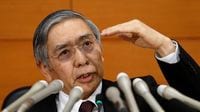TOKYO (Reuters) - When Fumiko Kasai returned to work a decade ago she found Japan's job market was very different to the one she had left in the 1980s to raise her four children.
Kasai, who had enjoyed a well-paid full-time job with a car firm before giving up work when she married, is now a temporary worker at a butcher's. Earning 200,000 yen ($1,835) a month, her hourly pay is around half that of a full-time worker doing the same job.
Prime Minister Shinzo Abe has put tackling Japan's labor inequality at the center of his policy agenda as the number of temporary workers hits a record high, posing a challenge to his "Abenomics" stimulus package ahead of a summer election.
"At first I saw nothing strange about a housewife doing a low-paid part-time job," 59-year-old Kasai said.
"But no matter how hard I worked, my salary would not rise much even as I bear the responsibility as a team leader. I don't want employers to treat temporary workers as cheap labor force for the sake of cutting personnel costs."
With part-time and temporary workers now making up about 40% of the labor force, Abe vows to adopt an "equal pay for equal work" scheme, forcing firms to pay the same wage for workers doing the same job.
Abe is counting on the plan - a centerpiece of a mid-year raft of policy announcements - to boost flagging consumption and win votes ahead of a July upper house election.
The move follows his decision to delay a scheduled sales tax hike by two-and-a-half years, putting his plans for fiscal reform on the back burner amid stubborn weakness in the economy.
But the plan could backfire on Japanese firms by pushing up labor costs and squeezing profits, analysts say. It also faces resistance from the businesses who would have to implement it.
"It will be a step forward towards fixing a labor gap," said Yuriko Kinoshita, a member of the Seikyo Roren representing co-op workers. "But it's hard to carry it out without support from the management and understanding from regular employees who worry about pay cuts in the name of equal pay for equal work."
Sadayuki Sakakibara, head of Japan's biggest business lobby Keidanren, has said he would support Abe's plan, but added: "We must consider Japan's own pay system and job practice, rather than just promising the same pay for the same job."
In the Reuters Corporate Survey earlier this year only 9% of Japanese firms described the plan as realistic.
Lost decades
Structural reform to boost consumption and revive growth is one of the "three arrows" of Abenomics - aimed at reviving the economy after two so-called lost decades of torpor and deflation - alongside fiscal stimulus and massive monetary easing.
But Abe has so far struggled to push labor reforms that would make it easier for companies to hire and fire, due in part to opposition from unions representing full-time employees.
Meanwhile, the gap has been growing between "regular" and "non-regular" workers. The former are full-time employees with permanent contracts and pay scales based on seniority; the latter are temps, part-timers and short-term contract workers with more precarious jobs.
Before Japan's bubble burst in the early 1990s, 80 percent of workers were full-time employees with job security, and most felt middle class. Last year, the share of non-regular workers in the labor force hit a record 37.5%.
Suzuka Watanabe, 53, a temporary store manager at a grocery, said her pay was about 60% of regular workers in the same job. Watanabe took up the job three years ago when her husband died and she had to raise their teenage son by herself.
"I agree there needs to be a system in which part-timers work for a short time and flexibly," Watanabe said. "But that doesn't mean part-timers should put up with lower hourly pay than full-time workers if they do the same job with the same responsibilities."
Masaki Kuwahara, senior economist at Nomura Securities, said Japan needed to make more use of women and older workers given its dwindling labor force.
"However, it will be difficult to implement such a policy anytime soon and the hurdle is high if you attempt to force it under Japan's traditional labor system, which is based on the lifetime employment and seniority-based wage system," he said.
Cheap labor force
Overall employees' annual pay stood at 4.15 million yen as of 2014, having peaked at 4.67 million yen in 1997, reflecting a steady decline in the number of well-paid full-time workers, government data shows.
Hourly wages for part-timers stand at 56.8% of those for full-time workers, excluding benefits.
In France, by comparison, the ratio is 89%, while in Germany it is 79% and in Britain and Italy about 70%, according to data from the Japan Institute for Labour Policy and Training, a semi-governmental institution.
The government aims to bring the wage differential between regular and non-regular workers to the same levels as in Europe.
"Labor inequality is becoming a serious problem even as companies are raising record profits," Masahiko Shibayama, special adviser to the premier, told Reuters. "To boost consumption, we must improve treatment of non-regular workers."
Fusako Hirasawa, a single mother of a seven-year-old girl, earns 150,000 yen-a-month as a temporary worker delivering door-to-door food and groceries near Tokyo five days a week, about 70% of what regular employees make.
"It's quite common nowadays for women to work regardless of being married or a single mother, so I hope companies treat workers more equally," she said.
($1 = 108.9800 yen)
(Reporting by Tetsushi Kajimoto; with additional reporting by Linda Sieg; Editing by Alex Richardson)



